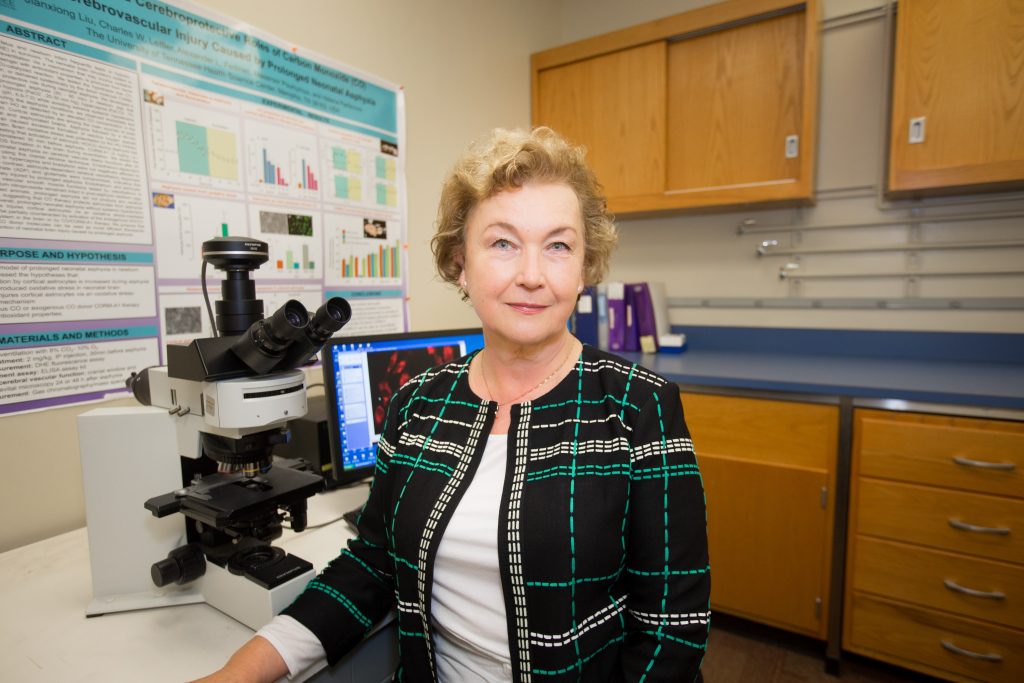
Helena Parfenova, PhD, professor of Physiology in the College of Medicine at the University of Tennessee Health Science Center (UTHSC), was recently awarded $2.1 million to further study the functions and mechanisms behind neonatal seizures, and to potentially uncover naturally-occurring defensive mechanisms to prevent cerebrovascular disease in newborns.
The neonatal brain is vulnerable to compromises in its blood supply because of its rapid development of neurons, and seizures are the most frequent abnormal neurological event in newborns. Neonatal cerebrovascular disease caused by oxidative stress during seizures, hypoxia/asphyxia, and ischemia can lead to debilitating and lifelong neurological complications. Presently, there is no effective treatment to prevent neurovascular dysfunction triggered by neonatal seizures.
“Brain oxidative stress is the main component of neurovascular damage caused by seizures, and endothelial cells are key elements of the neurovascular unit,” Dr. Parfenova said. “Strengthening antioxidant mechanisms in the neonatal brain can prevent endothelial cell damage during oxidative stress conditions.”
Dr. Parfenova is specifically focusing on a novel gaseous mediator, carbon monoxide (CO), which is naturally produced in the brain. In small amounts, carbon monoxide has proven to be a vital part of antioxidant defense mechanisms that promote endothelial cell survival in newborn brains.
“Our preliminary studies show that while head cooling does not stop seizures, it has proven to help reduce brain oxidative stress, prevent neonatal cerebrovascular disease, and protect blood-brain barrier integrity,” she said. “We want to uncover the phenomenon and key players by which this positive defensive reaction occurs.”
To test this hypothesis, Dr. Parfenova and her UTHSC collaborators, Jonathan H. Jagger, PhD, Maury W. Bronstein Endowed Professor in the Department of Physiology; and Massroor Pourcyrous, MD, professor in the Departments of Pediatrics and Physiology as well as practicing OBGYN, will use a combination of complementary techniques in a clinically-relevant study design. They will focus on the mechanisms that are responsible for stimulation of endothelial CO production and strengthening the antioxidant defense mechanism in the brain in response to head cooling. This research is unique, as it combines functional and mechanistic studies in unharmed cerebral circulation with analysis of the cellular and molecular mechanisms of endothelial vasoprotection by mild hypothermia.
“Head or total body cooling is currently only approved for caring for babies with neonatal hypoxic-ischemic insult, a type of brain damage that occurs when an infant’s brain does not receive enough oxygen and blood,” Dr. Parfenova said. “Additionally, no data has been available thus far on the use of head cooling to prevent the harmful effects of seizures on the neonatal brain. Therefore, we anticipate that head cooling may be used as an effective therapeutic approach to prevent neonatal cerebrovascular disease, protect blood-brain barrier integrity, and improve the neurodevelopmental outcome in babies with epileptic seizures.”
Her project titled, “Endothelial Vasoprotection by Hypothermia,” is being funded for five years by the National Institutes of Health.
